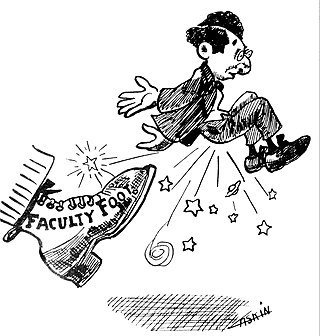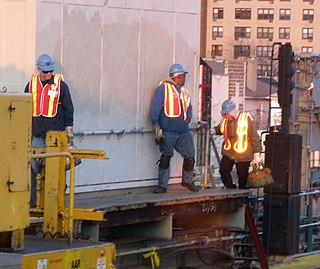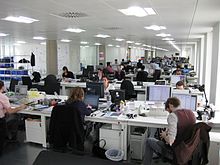
Carpentry is a skilled trade and a craft in which the primary work performed is the cutting, shaping and installation of building materials during the construction of buildings, ships, timber bridges, concrete formwork, etc. Carpenters traditionally worked with natural wood and did rougher work such as framing, but today many other materials are also used and sometimes the finer trades of cabinetmaking and furniture building are considered carpentry. In the United States, 98.5% of carpenters are male, and it was the fourth most male-dominated occupation in the country in 1999. In 2006 in the United States, there were about 1.5 million carpentry positions. Carpenters are usually the first tradesmen on a job and the last to leave. Carpenters normally framed post-and-beam buildings until the end of the 19th century; now this old-fashioned carpentry is called timber framing. Carpenters learn this trade by being employed through an apprenticeship training—normally four years—and qualify by successfully completing that country's competence test in places such as the United Kingdom, the United States, Canada, Switzerland, Australia and South Africa. It is also common that the skill can be learned by gaining work experience other than a formal training program, which may be the case in many places.

A tradesperson or tradesman is a skilled worker that specialises in a particular trade. Tradespeople (tradesmen) usually gain their skills through work experience, on-the-job training, an apprenticeship programme or formal education.

A blue-collar worker is a working class person who performs manual labor or skilled trades. Blue-collar work may involve skilled or unskilled labor. The type of work may involve manufacturing, warehousing, mining, excavation, carpentry, electricity generation and power plant operations, electrical construction and maintenance, custodial work, farming, commercial fishing, logging, landscaping, pest control, food processing, oil field work, waste collection and disposal, recycling, construction, maintenance, shipping, driving, trucking, and many other types of physical work. Blue-collar work often involves something being physically built or maintained.

A white-collar worker is a person who performs professional service, desk, managerial, or administrative work. White-collar work may be performed in an office or other administrative setting. White-collar workers include job paths related to government, consulting, academia, accountancy, business and executive management, customer support, design, economics, engineering, market research, finance, human resources, operations research, marketing, public relations, information technology, networking, law, healthcare, architecture, and research and development. In contrast: blue-collar workers perform manual labor or work in skilled trades; pink-collar workers work in care, health care, social work, or teaching; and grey-collar jobs combine manual labor and skilled trades with non-manual or managerial duties.

Termination of employment or separation of employment is an employee's departure from a job and the end of an employee's duration with an employer. Termination may be voluntary on the employee's part (resignation), or it may be at the hands of the employer, often in the form of dismissal (firing) or a layoff. Dismissal or firing is usually thought to be the employee's fault, whereas a layoff is generally done for business reasons outside the employee's performance.

A laborer is a skilled trade, a person who works in manual labor types, especially in the construction and factory industries. Laborers are in a working class of wage-earners in which their only possession of significant material value is their labor. Industries employing laborers include building things such as roads, road paving, buildings, bridges, tunnels, pipelines civil and industrial, and railway tracks. Laborers work with blasting tools, hand tools, power tools, air tools, and small heavy equipment, and act as assistants to other trades as well such as operators or cement masons. The 1st century BC engineer Vitruvius writes that a good crew of laborers is just as valuable as any other aspect of construction. Other than the addition of pneumatics, laborer practices have changed little. With the introduction of field technologies, the laborers have been quick to adapt to the use of this technology as being laborers' workforce.

A construction worker is a worker employed in the physical construction of the built environment and its infrastructure.
Embourgeoisement is the theory that posits the migration of individuals into the bourgeoisie as a result of their own efforts or collective action, such as that taken by unions in the United States and elsewhere in the 1930s to the 1960s that established middle class-status for factory workers and others that would not have been considered middle class by their employments. This process allowed increasing numbers of what might traditionally be classified as working-class people to assume the lifestyle and individualistic values of the so-called middle classes and hence reject commitment to collective social and economic goals. The opposite process is proletarianization. Sociologist John Goldthorpe disputed the embourgeoisement thesis in 1967.

A pink-collar worker is someone working in the care-oriented career field or in fields historically considered to be women's work. This may include jobs in the beauty industry, nursing, social work, teaching, secretarial work, upholstery, or child care. While these jobs may also be filled by men, they have historically been female-dominated and may pay significantly less than white-collar or blue-collar jobs.

Day labor is work done where the worker is hired and paid one day at a time, with no promise that more work will be available in the future. It is a form of contingent work.

In clothing, a collar is the part of a shirt, dress, coat or blouse that fastens around or frames the neck. Among clothing construction professionals, a collar is differentiated from other necklines such as revers and lapels, by being made from a separate piece of fabric, rather than a folded or cut part of the same piece of fabric used for the main body of the garment.
Grey-collar refers to the balance of employed people not classified as white- or blue collar. It is occasionally used to describe elderly individuals working beyond the age of retirement, as well as those occupations that incorporate some of the elements of both blue- and white-collar, and generally are in between the two categories in terms of income-earning capability.

Workwear is clothing worn for work, especially work that involves manual labour. Often those employed within trade industries elect to be outfitted in workwear because it is built to provide durability and safety.

A green-collar worker is a worker who is employed in an environmental sector of the economy. Environmental green-collar workers satisfy the demand for green development. Generally, they implement environmentally conscious design, policy, and technology to improve conservation and sustainability. Formal environmental regulations as well as informal social expectations are pushing many firms to seek professionals with expertise with environmental, energy efficiency, and clean renewable energy issues. They often seek to make their output more sustainable, and thus more favorable to public opinion, governmental regulation, and the Earth's ecology.
Blue collar workersin Japan encompass many different types of manual labor jobs, including factory work, construction, and agriculture. Blue-collar workers make up a very large portion of the labor force in Japan, with 30.1% of employed people ages 15 and over working as "craftsman, mining, manufacturing and construction workers and laborers" as of 1995 census data. The blue-collar class includes regular, non-regular, and part-time workers, as well as a large number of foreign laborers, all with varying work schedules and employment benefits.

Manual labour or manual work is physical work done by humans, in contrast to labour by machines and working animals. It is most literally work done with the hands and, by figurative extension, it is work done with any of the muscles and bones of the human body. For most of human prehistory and history, manual labour and its close cousin, animal labour, have been the primary ways that physical work has been accomplished. Mechanisation and automation, which reduce the need for human and animal labour in production, have existed for centuries, but it was only starting in the 18th and 19th centuries that they began to significantly expand and to change human culture. To be implemented, they require that sufficient technology exist and that its capital costs be justified by the amount of future wages that they will obviate. Semi-automation is an alternative to worker displacement that combines human labour, automation, and computerization to leverage the advantages of both man and machine.
Women's work is a field of labour assumed to be solely the realm of women and associated with specific stereotypical jobs considered as uniquely feminine or domestic duties throughout history. It is most commonly used in reference to the unpaid labor that a mother or wife performs in the home and family.

The working class includes all employees who are compensated with wage or salary-based contracts. Working-class occupations include blue-collar jobs, and most pink-collar jobs. Members of the working class rely exclusively upon earnings from wage labour; thus, according to more inclusive definitions, the category can include almost all of the working population of industrialized economies, as well as those employed in the urban areas of non-industrialized economies or in the rural workforce.
A new-collar worker is an individual who develops technical and soft skills needed to work in the contemporary technology industry through nontraditional education paths. The term was introduced by IBM CEO Ginni Rometty in late 2016 and refers to "middle-skill" occupations in technology, such as cybersecurity analysts, application developers and cloud computing specialists.

Color is an essential aspect of the aesthetic properties of clothing. The color of clothing has a significant impact on one's appearance. Our clothes communicate about us and reveal our social and economic standing.

















